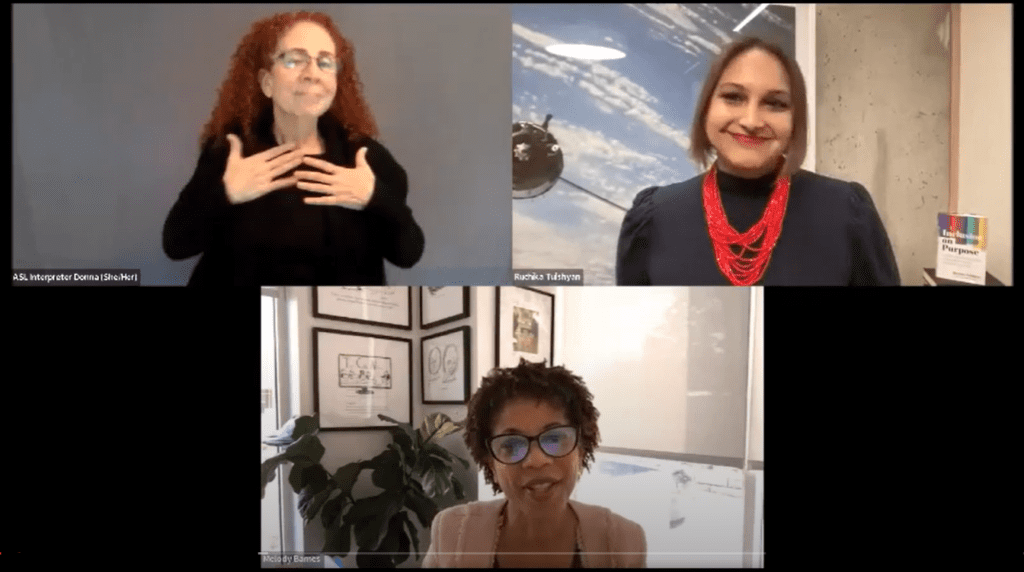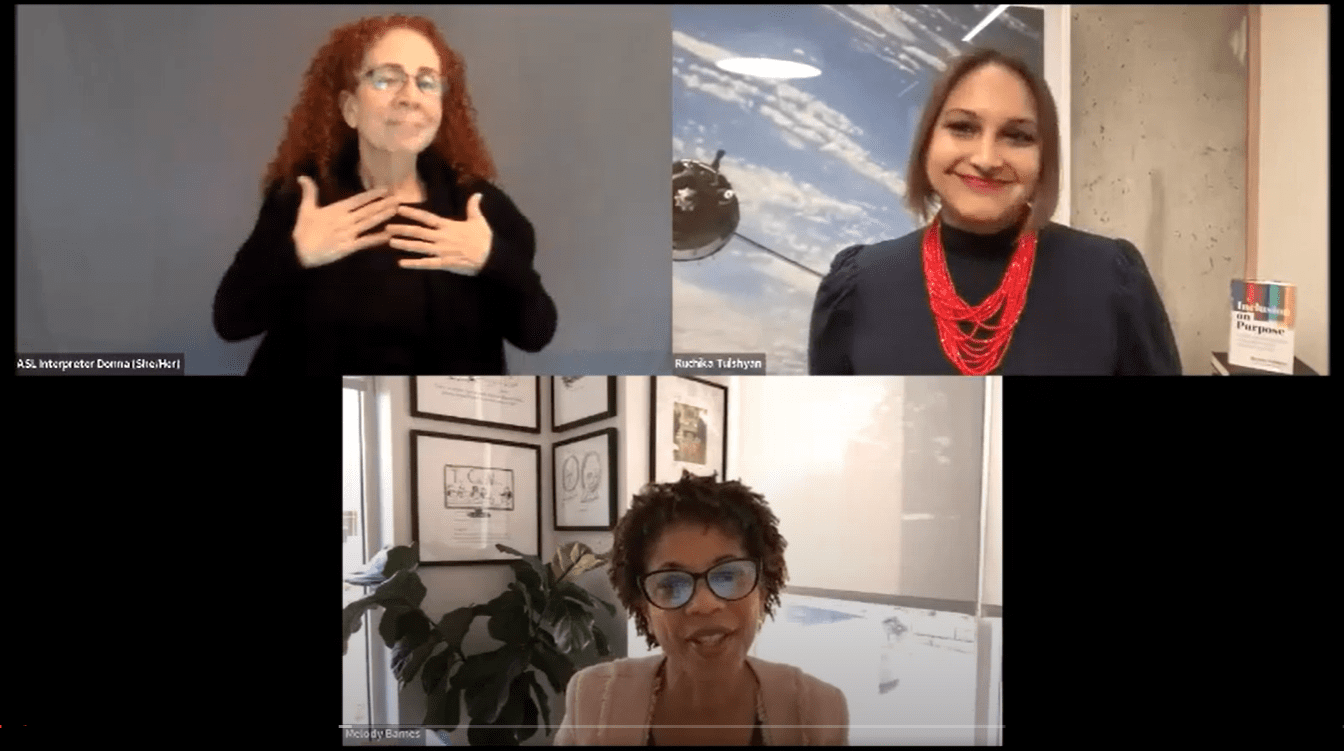
Ruchika Tulshyan and Melody Barnes at the 2023 Collective Impact Forum Action Summit.
“I believe in you. I see you.” Ruchika Tulshyan, award-winning inclusion strategist and best-selling author of Inclusion on Purpose: An Intersectional Approach to Creating a Culture of Belonging at Work, spoke these words during a rich dialogue with Melody Barnes (chair of Aspen Forum for Community Solutions and Opportunity Youth Forum) at the 2023 Collective Impact Action Summit. The fireside chat was insightful and left me with reflections of my own experience on belonging and the innovative ways to center DEI strategies going forward.
Belonging Defined
Ruchika defines belonging as when those often overlooked can make decisions, lead, and “feel like they can really bring their whole authentic selves.” Belonging is being able to hear in a trusted space, “I believe in you. I see you. You’re going to do great.” These validating and affirming words are especially important for young people from marginalized backgrounds. Ruchika talks about belonging from the individual and collective lens at the same time. She shares that belonging is about working through traumas and challenges (the individual) while cultivating a community (the collective) that amplifies and validates the individual. A culture of belonging and building community is collective self-healing.
For Ruchika, to belong also means to know what it is like not to belong. She shared with Melody and the audience her lived experience of growing up in a culture with strong views on women’s place in society as an Indian person of color from Singapore. She mentioned starting her career as a business journalist and met with many objections on the types of inclusive stories to highlight and witnessed similar and different injustices of others. Living and observing various forms of oppression ignited Ruchika to fully transition into the work of diversity, equity, inclusion, and belonging.
I, too, know what it means not to belong and to create spaces where I can belong as a Black woman with deep southern roots from Georgia. I attended a predominately-white institution in Massachusetts and worked in several corporate spaces as the minority, most—if not all—of the time. I recall moments in meetings of being interrupted and having an idea I shared be turned down or ignored, later to be celebrated by someone else. I will also acknowledge that despite the various “-isms” I have faced, I still felt a sense of belonging because I heard from trusted folks in my life the affirmations of “I believe in you, I see you, and keep going,” which has tremendously impacted my growth.
Being heard, seen, validated, and understood just for who you are speaks volumes. As Ruchika mentions during the chat, it can be the difference between getting the needed and continued support for growth versus not.
Diversity, Equity, and Inclusion (DEI) Defined
Diversity is to deeply and meaningfully center those historically marginalized and underestimated. Centering historically underestimated, underrepresented, and marginalized people benefits everyone. Ruchika’s definition of diversity is similar to the definition of the Curb-Cut Effect, which states, “When the wall of exclusion comes tumbling down, everyone benefits. When we target support to where it is needed most, everyone wins, and no one is left behind.”
Since diversity is about the intentional representation of voices often overlooked at the forefront, inclusion is when historically underestimated, underrepresented, and most marginalized communities can contribute and lead.
Ruchika views diversity and inclusion as outcomes that can be measured, yet defines equity as a process that makes for long-term sustainable change in addressing structural barriers and oppression. These structural changes can happen at an organizational level or a community/public policy level.
Ruchika provides an example of equity in action regarding employees covering upfront work-related costs and being reimbursed months after receipts are submitted. Even if employees are paid well, what should be considered are the lived experiences of employees, who may have limited means to cover upfront costs for various reasons, such as having dependents to support and being historically left out of building wealth. When organizations recognize and acknowledge that current policies with good intentions perpetuate systemic barriers and willingly work to make sustained changes for the betterment of those who need it most, this is a form of equity.
Ruchika highlights that even with a comprehensive HR handbook that proactively includes policies to advance equity, the work of DEI goes well beyond formal policy. DEI truly occurs in the day-to-day interaction when there is psychological safety. Ruchika defines this form of safety as the ability to speak up, take risks, or fail without feeling like you will be penalized and lose status.
There are several questions that Ruchika raises for change agents and practitioners to consider in any organization when attempting to promote the work of DEI:
- How are people in the dominant group practicing allyship? (Allyship is a verb, a continuous practice in every moment, vs. being an ally—a noun—and taking a stand once)
- Is there a culture where everyone has an opportunity to participate?
- Are “toxic rock stars” rewarded? (Someone who performs well and hits all work goals, yet is perpetuating forms of bias and oppression and disrespecting others)
Ways to Create Purposeful Spaces of Inclusion and Belonging
Ruchika and Melody explored several strategies for actively creating purposeful spaces of inclusion and belonging.
These practices can be adapted in any organizational setting or in creating the culture, norms, and practices of a collective impact initiative:
- Boldly name what is missing in the space (e.g., types of communities, leadership styles, or perspectives), then decide the plan of action to make changes.
- Boldly confront and identify the systemic barriers that hinder people of color and other underestimated identities from representation, participation, and belonging. Then, dismantle them because centering these voices benefits all.
- “Develop Empathy as an Inclusive Leader,” a principle from Inclusion on Purpose.
- Empathy in regard to leadership and cultivating change is to build understanding with a specific focus on how the experiences of those most marginalized and underestimated are impacted by the decisions and operations of a leader, organization, or collaborative initiative.
- “Shine the Light, Then Get Out of the Way,” a principle from Inclusion on Purpose, is a form of empathy that highlights the importance of passing the mic to those most marginalized and often silenced but not voiceless.
- Ruchika shared a wonderfully illustrative story of shining the light and getting out of the way through a story of Marilyn Monroe and Ella Fitzgerald. She explained that early in Ella’s singing career, many opportunities did not come her way. Yet Ella’s work inspired Marilyn, so Marilyn called the largest club in Hollywood and promised to be in the front row every day if Ella was allowed to perform on stage. Marilyn used her privilege and influence to make the call and sit in the front row (getting out of the way), and the stage was Ella’s to have her voice heard (shining the light).
I thoroughly enjoyed the insights shared during the fireside chat with Ruchika and Melody. All in all, I am walking away with a friendly reminder from Ruchika on creating purposeful spaces: “This is a life-long journey to build better systems for all.”

